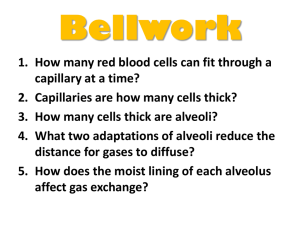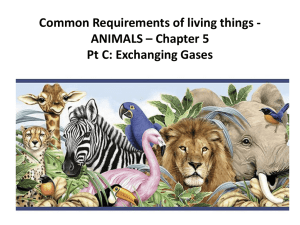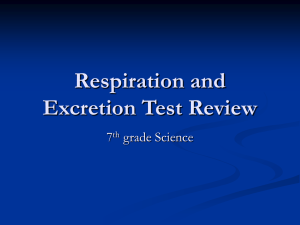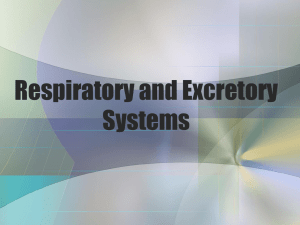as pe physiology revision exam questions & mark schemes
advertisement
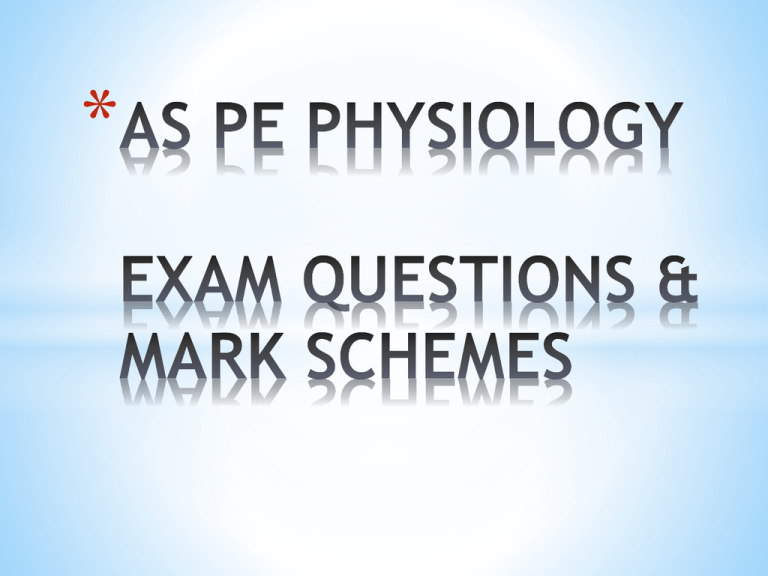
* * State 2 ways in which carbon dioxide is transported in the blood. (2 marks) * Dissolved in blood plasma (5 %) * Combined with haemoglobin in red blood cells (20%) * Combines with water to form bicarbonate ion / hydrogen carbonate(70%) For effective performance, games players require oxygen to be delivered to the muscles and carbon dioxide to be removed. Explain how oxygen is taken up by haemoglobin from the lungs and released at the muscle site. (4 marks) * Air in lungs has high PO2 (partial pressure of oxygen) / concentration of oxygen. * Low PO2 in deoxygenated blood returning to lungs. * Concentration / diffusion gradient means oxygen passes from alveoli into blood stream. * Same occurs at muscle site where there is a high PO2 in bloodstream and low PO2 in muscle cells. * Partially permeable membrane. * Carbon dioxide transported by the same process but in the opposite direction at each site (e.g. low PCO2 in oxygenated blood and high PCO2 in muscle cells). a) b) Explain why aerobic training improves the performer’s ability to transport oxygen. (2 marks) The alveoli provide the lungs with a large surface area for diffusion. Name two other structural features of the lungs that assist diffusion. (2 marks) a) * Cardiac hypertrophy leads to greater stroke volume / cardiac output * Greater capillary networks * Increased blood volume and haemoglobin levels b) * Permeability of alveoli (partially permeable membrane) * Short distance from alveoli to capillary * Slow movement of blood through capillaries * Moisture layer enhancing the uptake of oxygen Use the information in Figure 1 to explain how oxygen and carbon dioxide move between the two locations. (3 marks) Figure 1: pO2 = 104 mm Hg pCO2 = 40 mm Hg Alveolus pO2 = 40 mm Hg pCO2 = 46 mm Hg Blood capillary * High PO2 in alveolus, low in blood capillary (opposite for CO2) * Movement from area of high concentration to low concentration * Concentration / diffusion gradient a) b) How is breathing rate regulated by the body to meet the increasing demands of exercise during a game of netball? (3 marks) Describe the process of breathing from the point just before the start of inspiration until the end of expiration (5 marks) a) * Controlled by respiratory centre in medulla oblongata * Increase in CO2 levels / lactic acid / lower pH detected by chemoreceptors * Activity from brain in anticipation of exercise * Proprioceptors in muscles and joints detect movement * Increases in body temperature b) * Inspiration caused by lowering air pressure in lungs by increasing volume of lungs. * Achieved by diaphragm contracting and flattening and intercostal muscles lifting ribs up and out. * Air moves from area of higher pressure (atmosphere) to area of lower pressure (lungs). * Opposite occurs for expiration * Inspiration active process / expiration passive process (when at rest) Figure 2 is a graph showing the typical readings of a spirometer. Figure 2: A D C B E (a)Which lung volumes are represented by D and E? (2 marks) (b)How would you expect volumes A, B and C to be affected during a game of rugby? (3 marks) a) * D – vital capacity * E – residual volume b) * A – inspiratory reserve volume decreases * B – expiratory reserve volume decreases * C – tidal volume increases During a game of tennis, a player’s breathing rate may vary. a) Explain how increases in levels of carbon dioxide and acidity in the blood cause breathing rate to rise. (3 marks) b) Breathing rate increases to get more oxygen into the blood. Gaseous exchange involves oxygen diffusing across membranes. Identify the membranes involved in this diffusion and identify one characteristic of these membranes that allows diffusion to happen.(2 marks) a) * Detected by chemoreceptors * Message sent to respiratory centre in medulla oblongata * Activation of sympathetic nerve * Causes increased rate of contraction of diaphragm and intercostal muscles b) * Alveolar / muscle cell / capillary wall membranes * Thin membranes / one cell thick / partially permeable * Short distance between membranes * Moist surface a) Explain how oxygen is taken up by haemoglobin from the lungs and released at the muscle site. (3 marks) b) Explain why aerobic training improves the performer’s ability to transport oxygen. (2 marks) a) * Process of diffusion / high to low concentration * High PO2 in lungs, low in deoxygenated blood returning to lungs * High PO2 in oxygenated blood, low in muscle cells b) * Increased red blood cell levels / haemoglobin * Cardiac hypertrophy increases stroke volume / cardiac output * Greater capillary networks Explain the mechanics of breathing which allow a performer to fill the lungs with air during exercise. (3 marks) * Inspiration caused by lowering air pressure in lungs by increasing volume of lungs. * Achieved by diaphragm contracting and flattening and intercostal muscles lifting ribs up and out. * Air moves from area of higher pressure (atmosphere) to area of lower pressure (lungs). * Opposite occurs for expiration * Inspiration active process / expiration passive process (when at rest) Table 1 gives some data relating to the percentage concentrations of gases in air at various points of the breathing cycle. Inspired (%) Expired (%) At rest Expired (%) During exercise Oxygen 20 16 14 Carbon Dioxide 0.04 4 6 Nitrogen 79 79 79 Water vapour variable saturated saturated a) Use the information in the table to explain the functions of the lungs at rest and during exercise. (3 marks) b) Describe those characteristics of the structure of the lungs that make them an efficient respiratory surface. (3 marks) a) * Lungs intake oxygen / remove carbon dioxide * More oxygen used during exercise * More carbon dioxide produced during exercise b) * Permeability of alveoli and capillary cell walls * Short distance from alveoli to capillary * Readiness of haemoglobin to combine with oxygen * Diffusion gradient caused by differences in partial pressures * Large surface area of alveoli * Slow movement of blood through capillaries * Moisture layer enhances uptake of oxygen The diffusion of oxygen and carbon dioxide at the muscle site is an essential process for muscle activity. Describe how the process of diffusion works at the muscle site with reference to concepts of partial pressure and diffusion gradients. (6 marks) * Oxygenated blood has high PO2 (partial pressure of oxygen) / concentration of oxygen. * Low PO2 in muscle cells. * Due to muscle cells using oxygen to create energy. * Concentration / diffusion gradient means oxygen passes from bloodstream into muscle cell. * Partially permeable membrane. * Carbon dioxide transported by the same process but in the opposite direction at each site (e.g. low PCO2 in oxygenated blood and high PCO2 in muscle cells).
